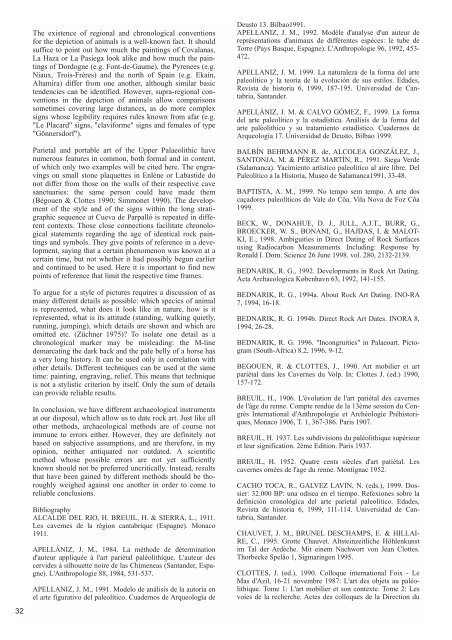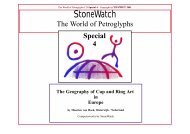Monts des Ksour" im Süd-Oranais / Nord-Algerien - StoneWatch
Monts des Ksour" im Süd-Oranais / Nord-Algerien - StoneWatch
Monts des Ksour" im Süd-Oranais / Nord-Algerien - StoneWatch
Erfolgreiche ePaper selbst erstellen
Machen Sie aus Ihren PDF Publikationen ein blätterbares Flipbook mit unserer einzigartigen Google optimierten e-Paper Software.
32<br />
The existence of regional and chronological conventions<br />
for the depiction of an<strong>im</strong>als is a well-known fact. It should<br />
suffice to point out how much the paintings of Covalanas,<br />
La Haza or La Pasiega look alike and how much the paintings<br />
of Dordogne (e.g. Font-de-Gaume), the Pyrenees (e.g.<br />
Niaux, Trois-Fréres) and the north of Spain (e.g. Ekain,<br />
Altamira) differ from one another, although s<strong>im</strong>ilar basic<br />
tendencies can be identified. However, supra-regional conventions<br />
in the depiction of an<strong>im</strong>als allow comparisons<br />
somet<strong>im</strong>es covering large distances, as do more complex<br />
signs whose legibility requires rules known from afar (e.g.<br />
"Le Placard" signs, "claviforme" signs and females of type<br />
"Gönnersdorf").<br />
Parietal and portable art of the Upper Palaeolithic have<br />
numerous features in common, both formal and in content,<br />
of which only two examples will be cited here. The engravings<br />
on small stone plaquettes in Enlène or Labastide do<br />
not differ from those on the walls of their respective cave<br />
sanctuaries: the same person could have made them<br />
(Bégouen & Clottes 1990; S<strong>im</strong>monet 1990). The development<br />
of the style and of the signs within the long stratigraphic<br />
sequence at Cueva de Parpalló is repeated in different<br />
contexts. Those close connections facilitate chronological<br />
statements regarding the age of identical rock paintings<br />
and symbols. They give points of reference in a development,<br />
saying that a certain phenomenon was known at a<br />
certain t<strong>im</strong>e, but not whether it had possibly begun earlier<br />
and continued to be used. Here it is <strong>im</strong>portant to find new<br />
points of reference that l<strong>im</strong>it the respective t<strong>im</strong>e frames.<br />
To argue for a style of pictures requires a discussion of as<br />
many different details as possible: which species of an<strong>im</strong>al<br />
is represented, what does it look like in nature, how is it<br />
represented, what is its attitude (standing, walking quietly,<br />
running, jumping), which details are shown and which are<br />
omitted etc. (Züchner 1975)? To isolate one detail as a<br />
chronological marker may be misleading: the M-line<br />
demarcating the dark back and the pale belly of a horse has<br />
a very long history. It can be used only in correlation with<br />
other details. Different techniques can be used at the same<br />
t<strong>im</strong>e: painting, engraving, relief. This means that technique<br />
is not a stylistic criterion by itself. Only the sum of details<br />
can provide reliable results.<br />
In conclusion, we have different archaeological instruments<br />
at our disposal, which allow us to date rock art. Just like all<br />
other methods, archaeological methods are of course not<br />
<strong>im</strong>mune to errors either. However, they are definitely not<br />
based on subjective assumptions, and are therefore, in my<br />
opinion, neither antiquated nor outdated. A scientific<br />
method whose possible errors are not yet sufficiently<br />
known should not be preferred uncritically. Instead, results<br />
that have been gained by different methods should be thoroughly<br />
weighed against one another in order to come to<br />
reliable conclusions.<br />
Bibliography<br />
ALCALDE DEL RIO, H. BREUIL, H. & SIERRA, L., 1911.<br />
Les cavernes de la région cantabrique (Espagne). Monaco<br />
1911.<br />
APELLÁNIZ, J. M., 1984. La méthode de détermination<br />
d'auteur appliquée à l'art pariétal paléolithique. L'auteur <strong>des</strong><br />
cervi<strong>des</strong> à silhouette noire de las Ch<strong>im</strong>eneas (Santander, Espagne).<br />
L'Anthropologie 88, 1984, 531-537.<br />
APELLANIZ, J. M., 1991. Modelo de análisis de la autoría en<br />
el arte figurativo del paleolítico. Cuadernos de Arqueología de<br />
Deusto 13. Bilbao1991.<br />
APELLANIZ, J. M., 1992. Modèle d'analyse d'un auteur de<br />
représentations d'an<strong>im</strong>aux de différentes espèces: le tube de<br />
Torre (Pays Basque, Espagne). L'Anthropologie 96, 1992, 453-<br />
472.<br />
APELLANIZ, J. M. 1999. La naturaleza de la forma del arte<br />
paleolítico y la teoría de la evolución de sus estilos. Eda<strong>des</strong>,<br />
Revista de historia 6, 1999, 187-195. Universidad de Cantabria,<br />
Santander.<br />
APELLÁNIZ, J. M. & CALVO GÓMEZ, F., 1999. La forma<br />
del arte paleolítico y la estadística. Análisis de la forma del<br />
arte paléolithico y su tratamiento estadístico. Cuadernos de<br />
Arqueología 17. Universidad de Deusto, Bilbao 1999.<br />
BALBÍN BEHRMANN R. de, ALCOLEA GONZÁLEZ, J.,<br />
SANTONJA, M. & PÉREZ MARTÍN, R., 1991. Siega Verde<br />
(Salamanca). Yac<strong>im</strong>iento artístico paleolítico al aire libre. Del<br />
Paleolítico a la Historia, Museo de Salamanca1991, 33-48.<br />
BAPTISTA, A. M., 1999. No tempo sem tempo. A arte dos<br />
caçadores paleolíticos do Vale do Côa. Vila Nova de Foz Côa<br />
1999.<br />
BECK, W., DONAHUE, D. J., JULL, A.J.T., BURR, G.,<br />
BROECKER, W. S., BONANI, G., HAJDAS, I. & MALOT-<br />
KI, E., 1998. Ambiguities in Direct Dating of Rock Surfaces<br />
using Radiocarbon Measurements. Including: Response by<br />
Ronald I. Dorn. Science 26 June 1998. vol. 280, 2132-2139.<br />
BEDNARIK, R. G., 1992. Developments in Rock Art Dating.<br />
Acta Archaeologica København 63, 1992, 141-155.<br />
BEDNARIK, R. G., 1994a. About Rock Art Dating. INO-RA<br />
7, 1994, 16-18.<br />
BEDNARIK, R. G. 1994b. Direct Rock Art Dates. INORA 8,<br />
1994, 26-28.<br />
BEDNARIK, R. G. 1996. "Incongruities" in Palaeoart. Pictogram<br />
(South-Africa) 8.2, 1996, 9-12.<br />
BEGOUEN, R. & CLOTTES, J., 1990. Art mobilier et art<br />
pariétal dans les Cavernes du Volp. In: Clottes J. (ed.) 1990,<br />
157-172.<br />
BREUIL, H., 1906. L'évolution de l'art pariétal <strong>des</strong> cavernes<br />
de l'âge du renne. Compte rendue de la 13ème session du Congrès<br />
International d'Anthropologie et Archéologie Préhistoriques,<br />
Monaco 1906, T. 1, 367-386. Paris 1907.<br />
BREUIL, H. 1937. Les subdivisions du paléolithique supérieur<br />
et leur signification. 2ème Edition. Paris 1937.<br />
BREUIL, H. 1952. Quatre cents siècles d'art patiétal. Les<br />
cavernes ornées de l'age du renne. Montignac 1952.<br />
CACHO TOCA, R., GALVEZ LAVIN, N. (eds.), 1999. Dossier:<br />
32.000 BP: una odisea en el tiempo. Refexiones sobre la<br />
definición cronológica del arte parietal paleolítico. Eda<strong>des</strong>,<br />
Revista de historia 6, 1999, 111-114. Universidad de Cantabria,<br />
Santander.<br />
CHAUVET, J. M., BRUNEL DESCHAMPS, E. & HILLAI-<br />
RE, C., 1995. Grotte Chauvet. Altsteinzeitliche Höhlenkunst<br />
<strong>im</strong> Tal der Ardèche. Mit einem Nachwort von Jean Clottes.<br />
Thorbecke Speläo 1, Sigmaringen 1995.<br />
CLOTTES, J. (ed.), 1990. Colloque international Foix - Le<br />
Mas d'Azil, 16-21 novembre 1987: L'art <strong>des</strong> objets au paléolithique.<br />
Tome 1: L'art mobilier et son contexte. Tome 2: Les<br />
voies de la recherche. Actes <strong>des</strong> colloques de la Direction du
















